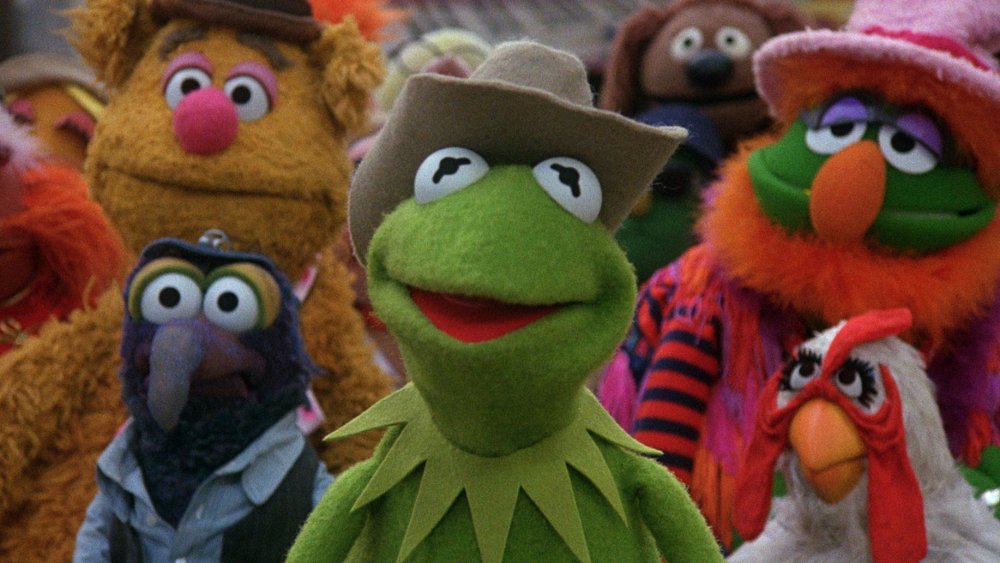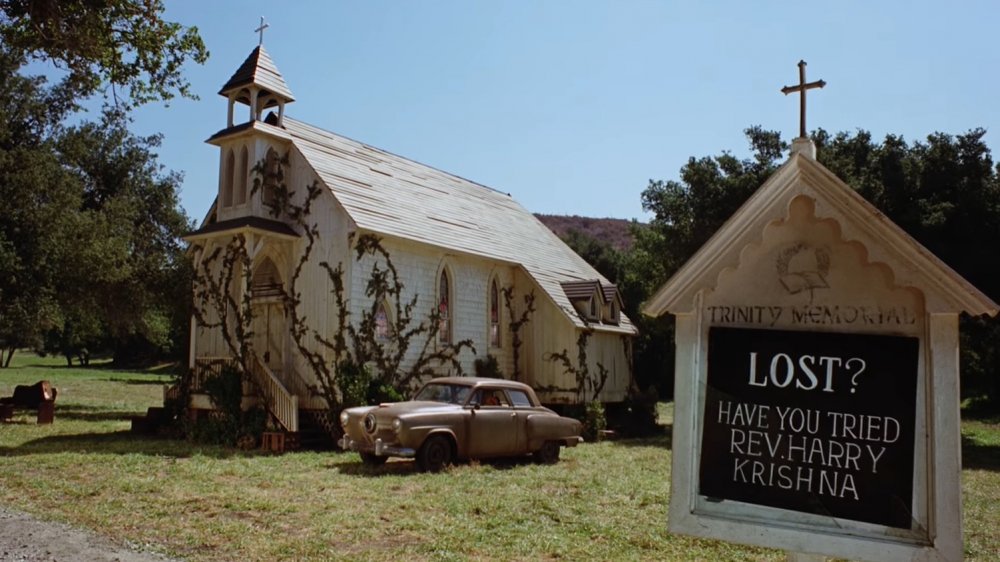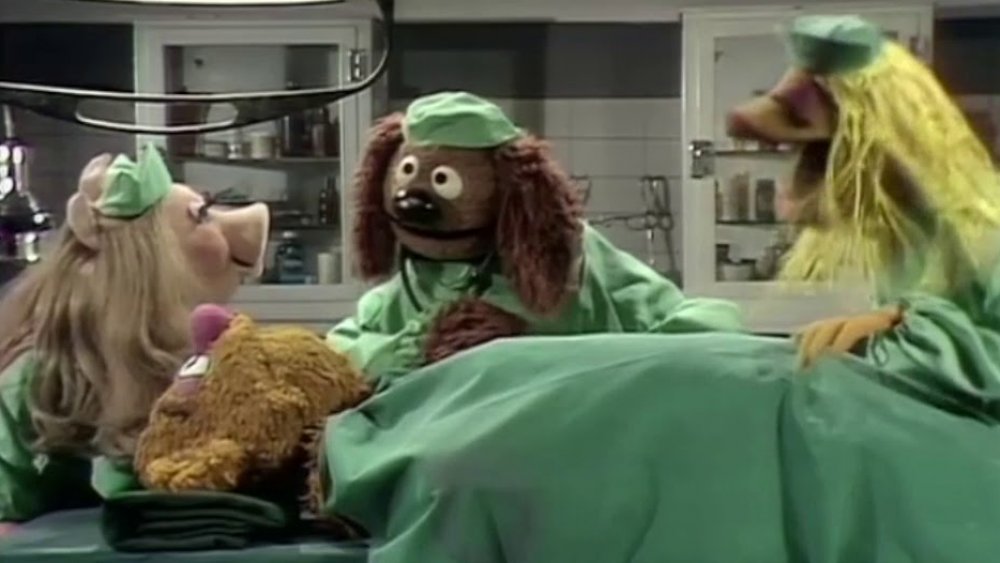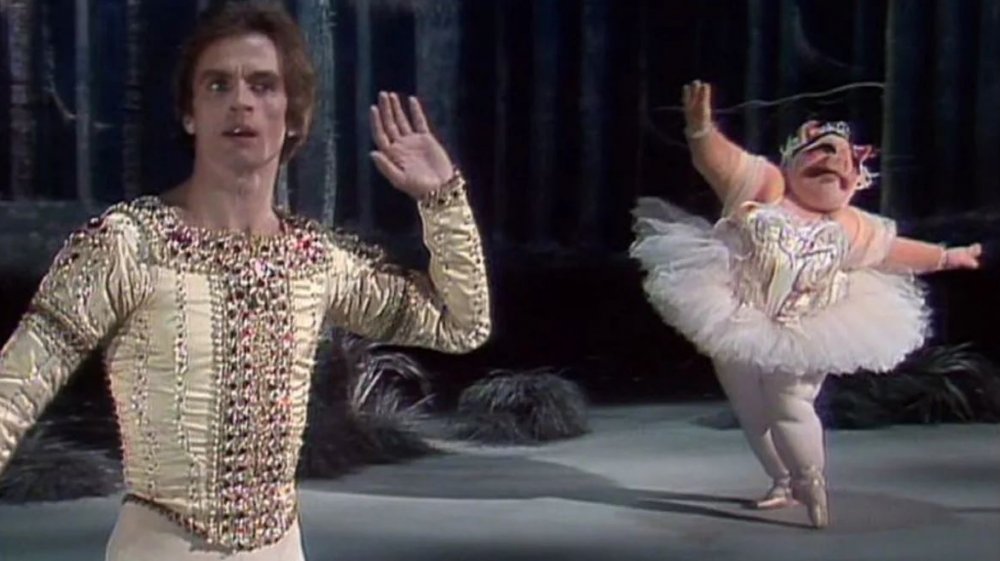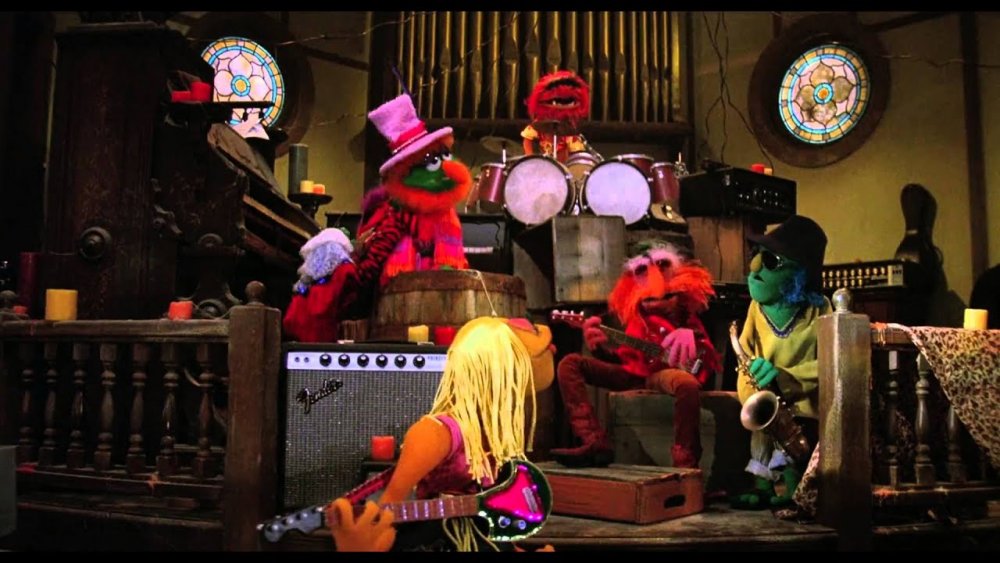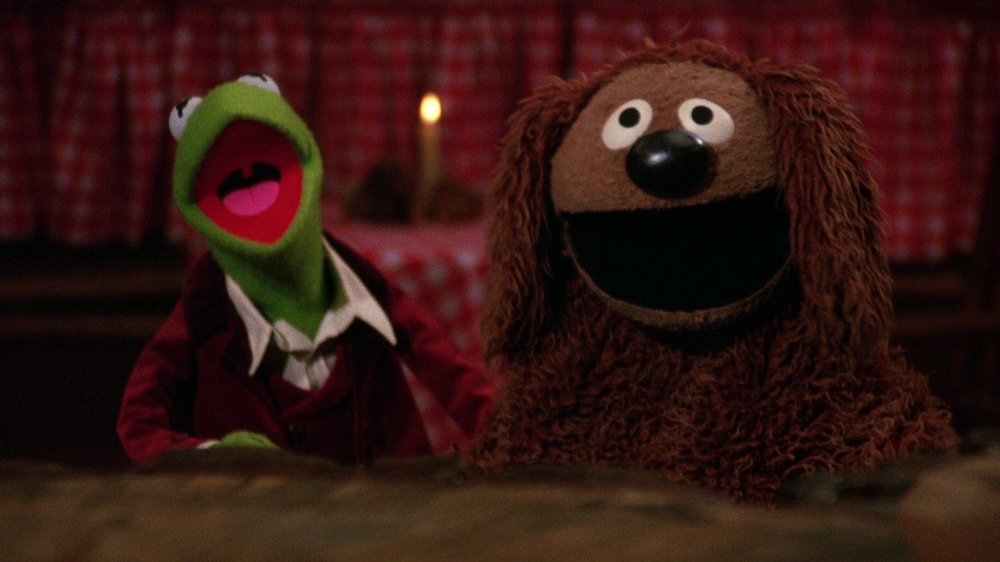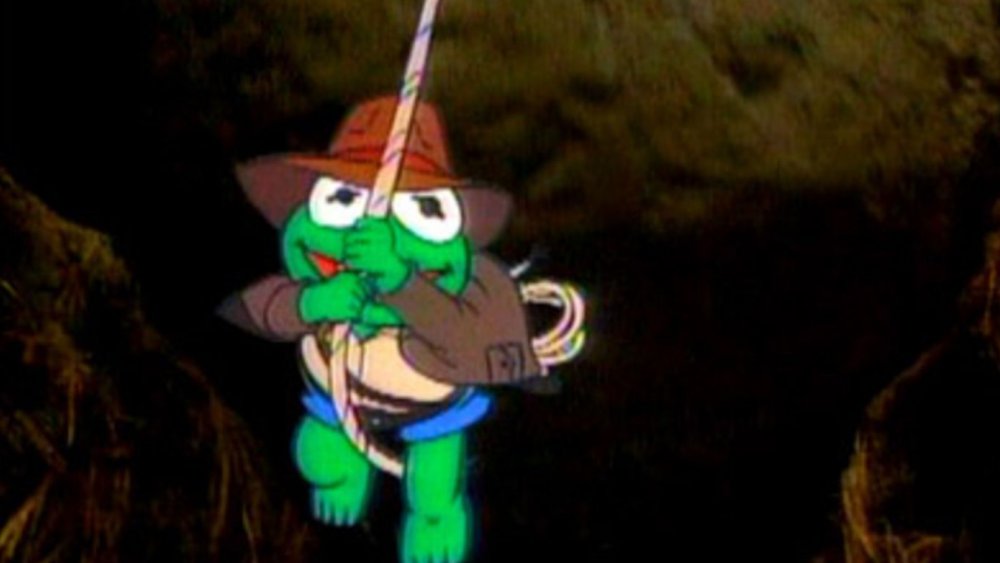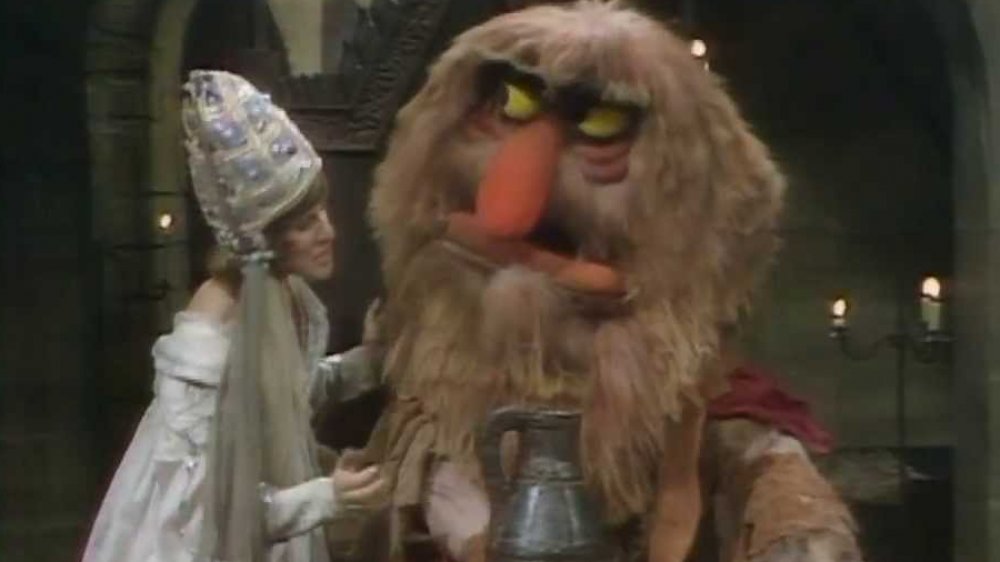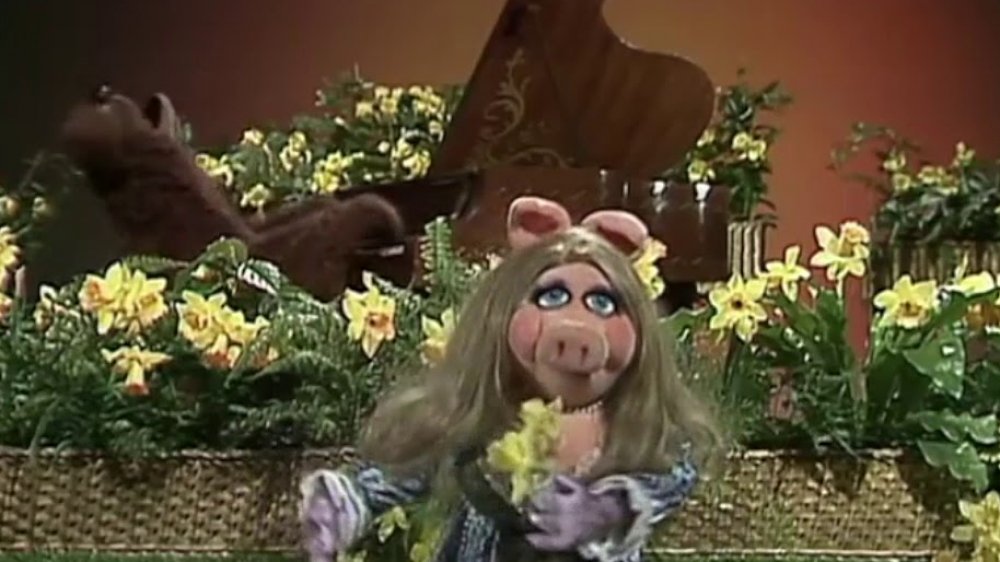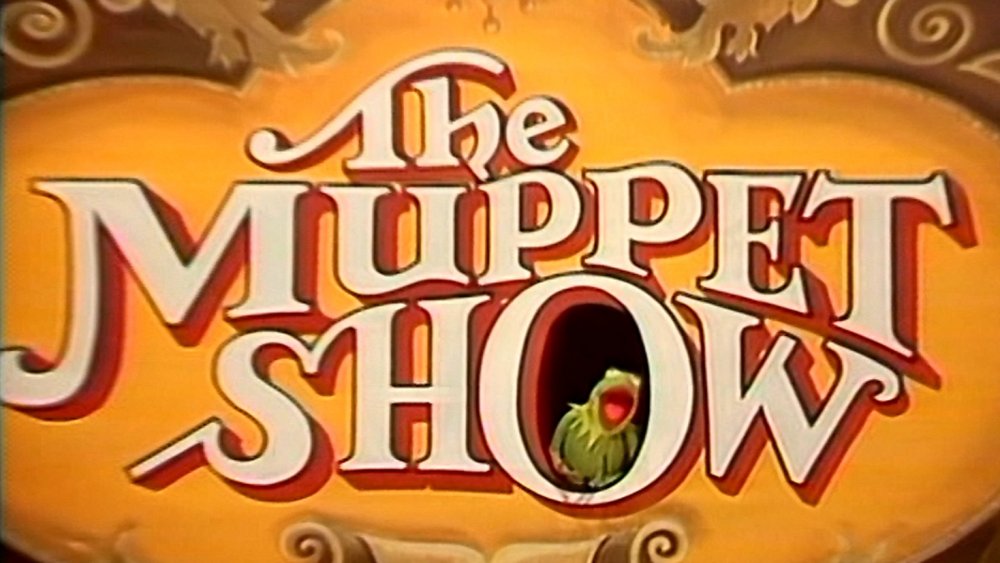Things Only Adults Notice About The Muppets
It's time to play the music, light the lights, and take a good look at the Muppets. There's something so enduring about this ragtag group of puppets that sprang forth from the talents of Jim Henson and his group of exceptional performers and artists. Part of that legacy surely has to do with the fact that the Muppets aren't just for kids, even though their felt faces make them seem too childish for adult tastes.
On the contrary, works like The Muppet Show and its surrounding films, TV spots, reboots, and reimaginings are some of the most pure examples of all-ages entertainment there is to be found. Kids love to watch the various soft and strange creatures traipse across the screen, and their parents love to indulge in the left-field humor and celebrity guest appearances. There's truly something for everyone who's willing to suspend their disbelief to watch a frog and a pig and a ... whatever ... come together to entertain, delight, and enthrall everyone — except those two hecklers they can't seem to escape! From the '70s until now, the Muppets have been a cultural touchstone for so many, and there's never a bad time to appreciate the ways in which they have continued to impress and engage an adult audience despite their appearance as children's fare.
Hare Krishna and the Muppets
The original rendition of The Muppet Movie is a brilliant, fun origin story that, for the most part, is timeless. However, there are ways in which it is very much a product of its time, such as with the running Hare Krishna gag. Hare Krishna is a religious movement founded in New York City in 1966, based around Hindu teachings. It was very popular in the '60s and '70s, a natural fit for those within the hippie movement. In other words, it was the perfect punchline for a 1979 comedy.
The film opens with Kermit the Frog sitting on a log in a swamp and playing the banjo. He's interrupted by a man (Dom DeLuise) frantically paddling a canoe and exclaiming that he's lost. Kermit suggests, "Have you tried Hare Krishna?" And thus the gag begins. Not long after, Kermit is observing Fozzie Bear's stand-up routine and mutters to himself, "This guy is lost." The barkeep behind him says, "Maybe he should try Hare Krishna," which forces Kermit to break the fourth wall and acknowledge the running gag straight to the audience. Finally, after driving for hours and hours on their way to make it big in Los Angeles, Kermit and Fozzie pull over at a run-down church to rest for a while. The board outside the church says, "Lost? Have you tried Rev. Harry Krishna?" completing the gag and observing the comedic rule of three. It's unlikely that kids would have too much awareness of this religious movement, but adults would be able to tie the references to the time period more easily.
All those primetime parodies
Ever since they first arrived in the '70s, the Muppets have asked their audience to be somewhat conversant with the tropes of television. And while kids might totally understand that the sketch "Pigs in Space" from The Muppet Show is a reference to Star Trek, they're less likely to see the similarities to Lost in Space, especially if we're talking about modern-day audiences. However, even kids back in the '70s probably wouldn't get that the character of Dr. Strangepork is named for the Stanley Kubrick film Dr. Strangelove.
And while kids then and now might have an interest in sci-fi television, it's less likely they'll be conversant in medical dramas, a genre pretty firmly directed at an adult audience. To this end, the pun-laden "Veterinarian's Hospital" parodies of General Hospital and its TV peers are likely underappreciated by The Muppet Show's younger views, though the silly jokes probably hit home for at least some of them.
The Muppet Show boasted an eclectic guest list
The Muppets have always loved their guest stars, but while some cameos are aimed towards kids, others were purely for grown-ups. That's especially true when it comes to The Muppet Show, the TV series that featured a new celebrity guest every episode. While kids back in the day definitely would've appreciated seeing Sylvester Stallone, Mark Hamill, or Christopher Reeve, chances are good they would've been baffled to see Johnny Cash, an undisputed legend of country music, happily singing a duet with Miss Piggy while backed by an all-puppet band.
And then there was Vincent Price, a classic horror fixture, who allowed his silliness to mix with his sinister side in one of the show's Halloween specials. More esoteric, artistic performers like the ballet dancer Rudolf Nureyev and the physical theater troupe Mummenschanz also took their less mainstream talents to the Muppet stage, seemingly unconcerned as to whether or not the venue or its audience was "highbrow" enough to appreciate their work. (Though admittedly, there's a lot that Mummenschanz, with their incredibly physicality and openness to the absurd, have in common with their Muppet hosts.)
Plus, Rita Moreno, one of the few people to win an Oscar, Emmy, Tony, and Grammy Award, showed off her stuff most memorably in a musical stand-off with Animal. Of course, if kids of the '70s had trouble identifying these stars, chances are good that modern-day children would be completely baffled when revisiting the show.
The Muppets' hippie happenings
Seeing as how the Muppets became popular in the 1970s, it makes sense that references to rock and hippie culture are baked into many of the characters themselves, most notably the members of Dr. Teeth and the Electric Mayhem. This ragtag group of musicians includes bassist and singer Floyd Pepper, whose name is a reference to Pink Floyd, as well as the Beatles album Sgt. Pepper's Lonely Hearts Club Band. While that might have been more obvious to the children of the '70s, it would be a stretch for modern kids unless their parents have a penchant for older rock.
On top of all that, lead guitarist and singer Janice, with her lethargic, spaced-out voice, drooping eyelids, and bell-bottom jeans, is a stereotypical stoned flower child. And during their performance of the song "Can You Picture That?" in The Muppet Movie, the band helps disguise Kermit and Fozzie's car by painting it in psychedelic rainbow colors — very typical of them but more perplexing to Kermit, who's a strait-laced frog. With their eccentric personalities, the Electric Mayhem surely appeal to kids, but their specific callback to free love and rock music might be a little less obvious, especially to those whose parents don't have ties to the hippie movement in any way.
Puppetry is far from child's play
When audience members are fully immersed in whatever they're viewing, it's easy for them to take the skills needed to entertain them for granted. Puppetry seems simple in many ways. You just put your hand in a puppet and make it talk by moving your hand, right? But really good puppetry makes you forget that you're watching something made merely of fabric, and the Jim Henson Company has always been outstanding at building and performing with many different types and complexities of puppets.
Adults are better equipped to step back from the entertainment and consider what goes into making it, as well as pick out how many of the performers are playing more than one puppet role. Jim Henson, best known for playing Kermit, was also responsible for Rowlf the Dog, Dr. Teeth, the Swedish Chef, Waldorf, and the infamous Mahna Mahna Muppet. Frank Oz, of course, played the delectable Miss Piggy, but also Fozzie Bear and Sam the Eagle. Jerry Nelson had Floyd Pepper, Camilla the Chicken, Robin the Frog, and Uncle Deadly in his regular roster.
Every Muppeteer also played lots of one-off parts, and many helped control Muppets who needed an extra pair of hands. For example, Oz helped Henson maneuver Rowlf and the Swedish Chef. And we haven't even mentioned all of the writers, creature creators, dancers, set designers, camera operators, and modern-day Muppeteers who make these funny critters of felt and glue come to life for their audience.
Taking aim at Hollywood
The Muppets have always enjoyed spoofing famous films and poking fun at Hollywood. The entire premise of The Muppet Movie, after all, is that Kermit leaves his swamp to pursue his Hollywood dreams, meeting a crew of stereotypical showpeople along the way. And in the 2011 comeback film, The Muppets, the gang has to push back against what's new and hip in Hollywood to get back together and get the theater up and running again.
But aside from this classic Hollywood success story, the Muppets enjoy a good parody. In an episode of Muppets Tonight, while guest star Pierce Brosnan tussled with anarchist lobsters on set, Muppet crooner Johnny Fiama sang his own unique version of the Goldfinger theme song. The opening animation of the 1980s cartoon Muppet Babies makes visual references to Indiana Jones, The Wizard of Oz, and Star Wars. And the one-hour TV special The Muppets Go to the Movies, co-starring Lily Tomlin and Dudley Moore, is one movie spoof after another, covering Casablanca, Gone With the Wind, The Three Musketeers, and a slew of Ingmar Bergman classics. Most of these movies, though culturally significant, wouldn't be part of the average kid's movie-watching roster, though they can probably appreciate the general desire the Muppets exhibit in becoming part of the glitz and glam of Hollywood.
The Muppets aren't afraid of edgy content
Sex is no stranger to the Muppets who, thankfully, mostly seem to be adults. One of the pilots that the Henson company put together for the original Muppet Show was actually titled "Sex and Violence," which gives you an idea of where they were coming from even at the start.
While never outright lewd, the gags on the shows and in the films like to skirt around mature humor, even before the recent ABC series, which was specifically intended to age the content up. From nearly the beginning, there was Animal, a walking, panting, grunting, drumming embodiment of the id, acting on all his most base needs without consideration or remorse. He has a penchant for exclaiming "woman!" any time he sees a member of the opposite sex he finds appealing, and he wastes no time before chasing them around.
And then there's Gonzo, who's in a long-term relationship with Camilla the chicken, which all of their peers seem to find odd. The two beaky lovers, however, are clearly smitten with each other. Plus, the entire episode of The Muppet Show with Raquel Welch ramped the sauciness factor up to 11, including some implications about Kermit and Piggy's sex life. And the cherry on the sexy cake is the hilariously fun Muppet Show duet between Sweetums and Ruth Buzzi, singing "Can't Take My Eyes Off of You" while throwing each other across the stage and hitting each other over the head with furniture.
Their literary leanings
Though they love the limelight, the Muppets are far from being solely influenced by cinema. They are, after all, stage performers who appreciate the written word. As such, they've featured a decent amount of poetry in their endeavors — poetry that would likely not be recognized immediately by an audience who hasn't reached that unit in their English classes yet.
Fozzie, though known best for his stand-up comedy, once attempted to go the more literary route in The Muppet Show with a thoughtful recitation of Robert Frost's "Stopping by Woods on a Snowy Evening." Unfortunately, he was interrupted by Gonzo and a group of tangoing chickens. Likewise, Miss Piggy was thwarted in her efforts to recite William Wordsworth's "The Daffodils" after both she and Rowlf fell victim to fits of sneezing. And Scooter and Rowlf were joined by slithy toves, borogoves, and mome raths in a remarkably straight recitation of Lewis Carroll's nonsense poem "The Jabberwocky" — a natural choice for the absurdist nature of The Muppet Show, to be sure. Hopefully, once young viewers have a chance to read these poems in their full, intended format, they'll fondly remember their first introduction from a bunch of earnest puppets.
The Muppets keep the stage lights burning
We live in an age where anything can be obtained over the internet, including books, clothes, movies, television shows, and music. When The Muppet Show had its initial run in the '70s, the entertainment landscape was changing as well, with many households opting to own a TV set and staying home to enjoy an evening of their favorite programs. It was becoming less and less popular to attend theatrical performances — an attitude that still exists to this day.
So it's a wonder that a huge part of the Muppets' entire existence hinges on the group valiantly trying to keep theater alive, struggling to make their variety show — very much modeled on old vaudeville and burlesque cabarets of a bygone era — a success. While the desire to make it despite the odds is relatable enough, the trappings of stage lighting, dressing rooms, and greasepaint would be less familiar to the young, even more so in our modern era. Perhaps that's part of the Muppets' charm. They're a throwback to a simpler time, a commentary on not allowing the arts to die, and an ode to embracing the surreal, the absurd, and the downright strange. They are, in a word, muppetational, and they will hopefully continue to sing and dance in the imaginations of young and old alike for many generations to come.
